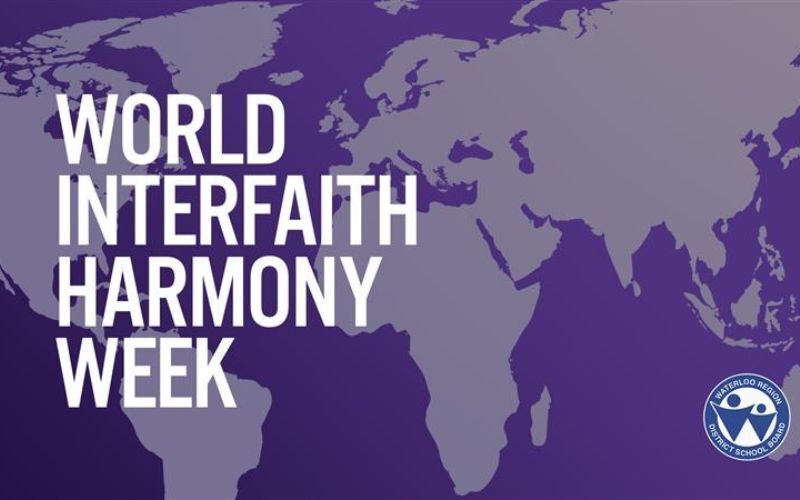We've Come a Long Way to Be Together, You and I
Part One
"We've come a long way to be together, you and I." Watch on Youtube, 3:49

"We've come a long way to be together, you and I" is the theme for this year's Charter for Compassion's contribution to the World Interfaith Harmony Week. You were listening to Bernice Johnson Reagon who recorded her own rendition of the spiritual over a decade ago. We chose the song not only for its profound words, but as the title for our World Interfaith Harmony this year.
Interfaith is a movement, just as the Charter for Compassion is a movement. These two global campaigns are all about bringing our minds, hearts and hands into the struggle-a struggle that counts on communities to not only accept and acknowledge difference, but to appreciate it-difference of faith and religion-both always affirming the rights of justice, freedom and equality.
Our two-part program will delve deeply into the real purpose of "Interfaith" and explore how its concept should be a guiding light into the harmony that is possible through interfaith practice which is the true foundation of living in a more peaceful and just world.
Getting to know the other as the Jewish philosopher, Martin Buber implied, is the ability to look at another from a different perspective, not leaving our own perspective behind, but broadening our understanding of the other-totally recognizing our willingness to accept an "I" and "Thou" relationship that is not separated by culture or faith or other bounds. This relationship conceivably leads us to the threshold of realizing the Eternal "Thou."

This interfaith journey is not easy, not without setbacks and difficult encounters. Since the birth of the Interfaith movement at the 1893 gathering of the Parliament of World Religions, Interfaith has come a long way in making a difference in small hamlets and in large cities. While there are many guiding principles associated with Interfaith, we thought we would share seven that come from the celebration of Kwanzaa, a week-long tradition held in the United States and in other nations of the African diaspora. Here sung by Sweet Honey in the Rock, an a cappella group founded by Bernice Johnson Reagon, seven principles of Kwanzaa: 1.Umoja (Unity) 2.Kujichagulia (Self-Determination): 3.Ujima (Collective Work and Responsibility): 4.Ujamaa (Cooperative Economics): 5.Nia (Purpose): 6. Kuumba (Creativity) 7. Imani (Faith) are explained through song.
"Sweet Honey in the Rock-Seven Principles." Watch on Youtube, 2:58

Certainly while each of the principals of Kwanzaa are related to interfaith let's continue to get radical-getting to the root-of the meaning of interfaith and emphasizing again how interfaith is a necessary component of peace building. We've all had the experience of listening to a "canned" telephone call. This time the canned call is about "What is the meaning of Interfaith dialogue.
"What is Interfaith Dialogue?" Watch on Youtube, 2:49

Let's take another look at not only the meaning of Interfaith, but explore the history associated with it. This time we are presenting a short documentary prepared by the ASHA Centre, located in Gloucester, UK. At ASHA people from around the world come to experience the richness of each other's cultures and to practice living together in a spirit of human unity-this often includes young people coming from places torn apart by conflict and war. ASHA is a place of safety and beauty, where all faiths are honored and where people of different nationalities and religions live and work side by side.
Here is ASHA's documentary on Interfaith Dialogue.
"Interfaith Dialogue Documentary". Watch on Youtube, 11:32

There is so much we don't know. We need to learn how to admit it-- "I don't know." Too often we are stuck in our own wisdom-or lack of it. Interfaith urges us to explore what we don't know and to arrive at a new understanding of the other. In the following presentation Karen Armstrong talks about the need we should cherish-- to be respectful of others.
"How Little We Know." Watch on Youtube, 16:36
Today we have explored the concept and meaning of interfaith, spent some time on the history and how we got to the need for an interfaith movement, considered how it is just fine to admit what we don't know, and hopefully have shed some light on how being active in interfaith brings us to a new understanding of others and offers us the beginning steps of moving towards building peace within our communities and in the world.

We started out with Bernice Johnson Reagan and Sweet Honey in the Rock. Let's end with their musical rendition of Sometimes. "Sometimes day breaks in my life" is the first line followed by "Sometimes the sun shines in my life and sometime things work right in." This is at the heart of Interfaith, it is a breakthrough, a light bringing new understanding. Join us tomorrow as we explore new issues and challenges that we face as we continue on the compassionate road to interfaith. Now, Sweet Honey in the Rock.
"Sometimes". Watch on Youtube, 4:45
Part Two
Welcome to our second program for the Charter’s celebration of World Interfaith Harmony Week. We want to begin today’s program with an upbeat message—one that has its roots in the Interfaith movement—a challenge to listen to people who we might see as "the other" – our enemy, a stranger, a threat – and open ourselves to the potential of caring and recognizing our commonalities.

In 2009, Noa, a Jewish-Israeli, and Mira Awad, an Arab-Israeli, performed a song, “There Must be Another Way” in Moscow, Russia as part of the Eurovision contest. The song conveys a message of hope and understanding. The singers describe "There Must Be Another Way" not as a song of peace, but as a simple call to respect the humanity of others. There was some controversy about the duo performing together for Eurovision. Several Jewish and Arab local artists and intellectuals called for Awad to step down because, in their view, her participation would convey a false impression of national coexistence that would be used to cover up the deaths of Palestinian civilians in the Gaza Strip. In an interview. Awad acknowledged this criticism, and said, "We're not naïve enough to think that we're representing any existing situation. We are trying to show a possible situation that we believe is possible if we just make the necessary efforts.” This is the core of Interfaith—we must participate in the movement because it is necessary.
"Noa and Mira Awad: We Can Work It Out". Watch on Youtube, 3:50
 Now let’s take a journey to Chicago and view a student-made film on Interfaith dialogue, actually a silent film, made by students at DePaul University. It’s a short film that relies four possible ways of having interfaith dialogue. Let’s take a look.
Now let’s take a journey to Chicago and view a student-made film on Interfaith dialogue, actually a silent film, made by students at DePaul University. It’s a short film that relies four possible ways of having interfaith dialogue. Let’s take a look.
"Four Ways of Interfaith Dialogue." Watch on Youtube, 3:32
If you’ve participated in other Charter for Compassion activities you likely know that the Interfaith Amigos are favorites. Rabbi Ted Falcon, Pastor Don Mackenzie, and Imam Jamal Rahman in a TED talk addressed the theme of Radical Collaboration.
 In a time when religion appears to be at the heart of fragmentation, suspicion and conflict, their friendship is a beacon to a wiser, more compassionate, and hopeful path. Here they are addressing the topic “Breaking the Taboos of Interfaith Dialogue.”
In a time when religion appears to be at the heart of fragmentation, suspicion and conflict, their friendship is a beacon to a wiser, more compassionate, and hopeful path. Here they are addressing the topic “Breaking the Taboos of Interfaith Dialogue.”
"Breaking the Taboos of Interfaith Dialogue." Watch on Youtube, 10:37
In our first segment we talked about how being a part of the Interfaith movement demands that we engage in compassionate action. The First Nation musical group, the Ulali project, commits itself to action. In the words of its founder, Pura Fe, an heir to the Tuscarora Indian Nation: “I place myself in the time-honored perspective of someone who accepts to bear the responsibilities inherited from my ancestors.”
 In Idle No More, the anthem of Ulali, we find a call to walk in the light with a drum, a song and a pray to bring about change—Idle No More.
In Idle No More, the anthem of Ulali, we find a call to walk in the light with a drum, a song and a pray to bring about change—Idle No More.
"Ulali Project Idle No More." Watch on Youtube, 3:21
From the message of Ulali, in "Idle No More" to a 2009 address by Eli Wiesel, presented to 16,000 youth at We Day in Toronto, Canada. Here we learn again that in order to stand with humanity, we must act in each other’s behalf.
 Wiesel was a Romanian-born American Jewish writer, professor, political activist, Nobel Laureate, and Holocaust survivor. In one of his most famous quotes, Wiesel reminds us: The opposite of love is not hate, it's indifference.
Wiesel was a Romanian-born American Jewish writer, professor, political activist, Nobel Laureate, and Holocaust survivor. In one of his most famous quotes, Wiesel reminds us: The opposite of love is not hate, it's indifference.
In the Interfaith movement we learn first to set aside our discomforts and prejudices, experience listening to and learning from others, come to know the other, accept and acknowledge differences and then appreciate that difference. In his speech, Wiesel helps us understand that the person we see in the street is a fellow sojourner, a potential friend.
"Elie Wiesel Speaks at We Day Toronto." Watch on Youtube, 7:36
 That's Susan Salidor singing Eli, Eli. “Oh Lord, My God,” a song taken from a poem written by Hannah Szenes. Szenes was trained by the British army to parachute into the former Yugoslavia during the Second World War in order to help save the Jews of Hungary, who were about to be deported to the German death camp at Auschwitz. She was arrested at the Hungarian border, imprisoned, tortured, eventually tried and executed by firing squad.
That's Susan Salidor singing Eli, Eli. “Oh Lord, My God,” a song taken from a poem written by Hannah Szenes. Szenes was trained by the British army to parachute into the former Yugoslavia during the Second World War in order to help save the Jews of Hungary, who were about to be deported to the German death camp at Auschwitz. She was arrested at the Hungarian border, imprisoned, tortured, eventually tried and executed by firing squad.
"Eli Eli by Susan Salidor." Watch on Youtube, 2:09
Our second program is coming to an end. We are grateful for your participation and hope that in these two days we have presented inspiring and challenging moments. We’d very much enjoy hearing from you.
 We are closing with an interfaith service, Way of Unity and Peace, an event sponsored by the Vatican in 2015.
We are closing with an interfaith service, Way of Unity and Peace, an event sponsored by the Vatican in 2015.
The closing song, Amazing Grace, is sung here by Darlene Zschech, best known as a Pentecostal singer and songwriter from Australia, Don Moen, American singer-songwriter, pastor, and producer of Christian worship music, Italian tenor, Andrea Bocelli and once again, Israeli singer, Noa.
"Conmueve al Papa Francisco al Cantar Amazing Grace." Watch on Youtube, 4:20
This year's program was written and researched by Marilyn Turkovich. Presented by Reed Price.
Watch Part One on YouTube, 46:54 - Or Listen to Part One on Soundcloud
Watch Part Two on YouTube, 42:39 - Or Listen to Part One on Soundcloud


